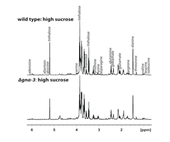Highlight
Use of 1H NMR to measure intracellular metabolite levels during growth and asexual sporulation in Neurospora crassa
Achievement/Results
As part of the University of California Riverside’s ChemGen Interdisciplinary Graduate Education, Research and Training (IGERT) program, experts in different fields collide during mandatory research rotations. Students generate research proposals inspired by the cross-training experience, incorporating experimental methods outside of their primary discipline. Molecular geneticist James Kim from the lab of Dr. Katherine Borkovich in Plant Pathology joined efforts with Dr. Cynthia Larive in Chemistry. The role of G-proteins, found on the surface of cells and responsible for signaling, and its role in fungal growth and pathogenesis were of interest to Kim and Borkovich, whose extensive studies in the model filamentous fungus Neurospora crassa had resulted in a great deal of resources and knowledge. Analytical chemists Kayla Kaiser and Prof. Larive had been establishing a pipeline for proton nuclear magnetic resonance spectroscopy (1H-NMR) metabolic profiling using the model plant Arabidopsis thaliana. The advantage of this method is that metabolite identity as well as concentrations can be recorded, providing a molecular snapshot of how the organism is functioning in response to its environment.
This study represented the first report of N. crassa metabolite levels using 1H-NMR. Two ChemGen IGERT trainees collaborated to more effectively study changes in cellular processes. By comparing the metabolome of Neurospora crassa wild-type strain and Δgna-3 mutant, these trainees successfully assessed the effect of genetic interruption of a key signaling pathway on the cellular metabolome. When the Δgna-3 mutant is submerged it precociously produces spores, its future generation. Non-mutant (wild-type) Neurospora crassa limits asexual sporulation under submerged conditions. The comparative evaluation of the metabolites in these genetically distinct fungi determined that levels of only a limited numbers of the metabolites change when gna-3 is deleted and the fungi are grown in the presence of sucrose, also that the asexual spores are metabolically distinct from the vegetative structures. Figure 1 shows the NMR spectra for both wild-type and Δgna-3 mutant, illustrating this point. This work was recently accepted in a peer-reviewed journal Eukaryotic Cell.
Address Goals
We were able to quantitate most of the amino acids, several sugars and other compounds. Our data correlates very well with results from other studies in the literature.






